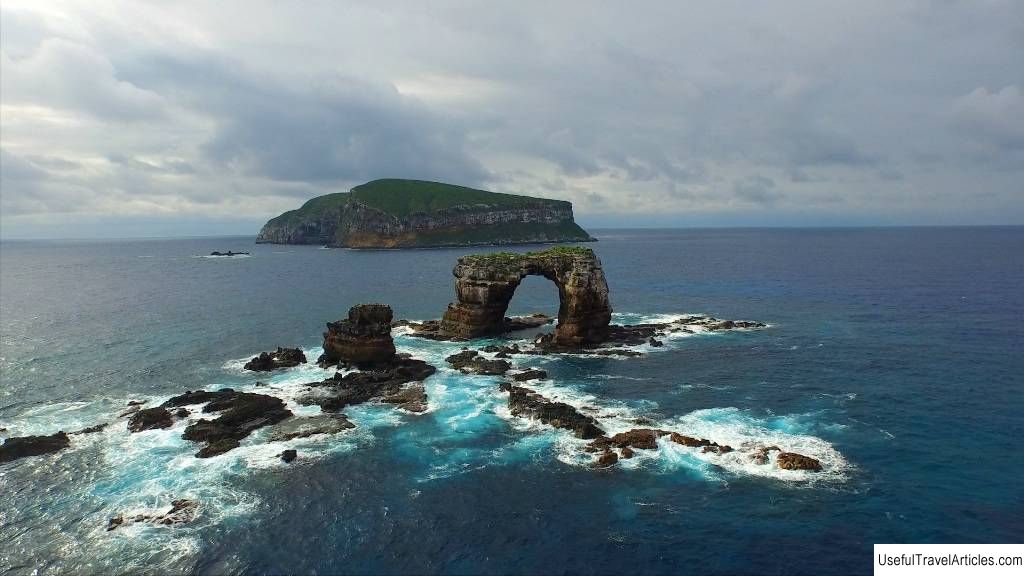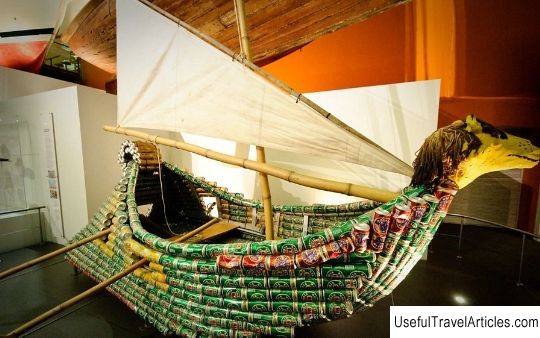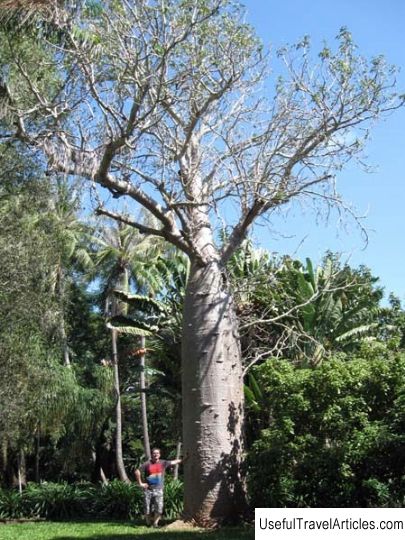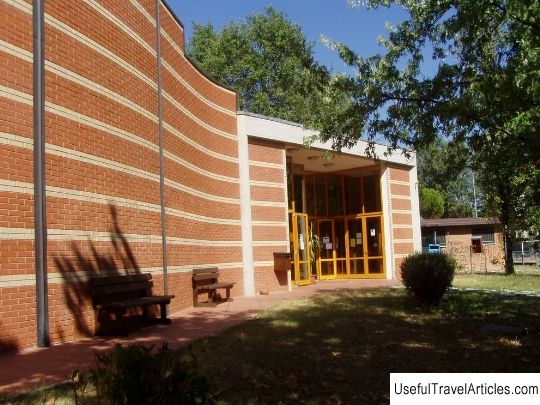Darwin Museum description and photos - Russia - Moscow: Moscow
Rating: 7,8/10 (1039 votes) 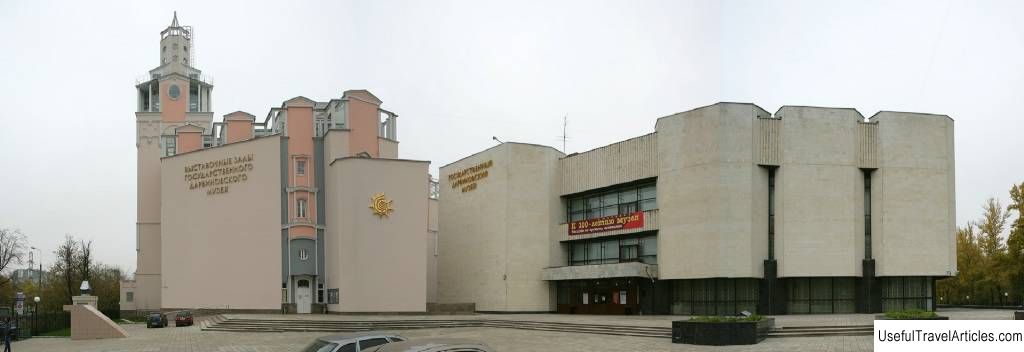
Darwin Museum description and photos - Russia - Moscow: Moscow. Detailed information about the attraction. Description, photos and a map showing the nearest significant objects. Photo and descriptionThe theory of evolution, published by Charles Darwin in 1859 in the book "The Origin of Species", has caused a stormy response from both scientists and ordinary people. Who supported the theory with all his heart, biology student Alexander Kots decided to create a museum in Moscow dedicated to the theory of evolution . So at the beginning of the twentieth century, the Darwin Museum appeared, which is now called one of the most significant among its kind in the world. His collection clearly demonstrates the processes of evolution, natural selection in nature and the struggle for the existence of biological species, which results in numerous changes in flora and fauna on our planet. Founder of the Darwin MuseumAlexander Kots was born in 1880 in a family of emigrants from Germany. His father was a botanist and doctor of philosophy, and his mother was the daughter of a forester. It is not surprising that Alexander from his youth was fond of studying the animal world , and he considered his love for nature a legacy from his parents. Already at the gymnasium, he began to take lessons in animal dissection and began to study taxidermy. The first scientific expedition of Kots took place at the age of 19, when the founder of the Moscow taxidermy school F. Lorenz helped the young man to take part in a scientific trip. The trip to the southern part of Western Siberia was very fruitful: Kots made more than a hundred stuffed animals and birds, for which he received a large silver medal of the Russian Scientific Society. Later, this particular collection will form the basis of the exposition of the Darwin Museum. Alexander Kots entered Moscow University and during his studies he repeatedly visited European educational institutions, biological stations and museums. After graduating from the university, he stayed at the department and began to prepare for receiving a professorship. History of the museum The date of foundation of the Darwin Museum is 1907, when Alexander Kots was offered a place at the Moscow Higher Courses for Women . The natural science assistant began to lecture on the doctrine of evolution. The collection of scarecrows followed him as visual aids and was placed in the premises of the courses. Two years later, F. Lorenz dies, from whom the young Kotz learned the basics of taxidermy. The young teacher buys from the heirs Lorenz's collection , which consisted of hundreds of stuffed birds and animals, among which were rare and endangered ones. Later, Cotes goes on a trip to the cities of Europe, where he acquires many rarities, one way or another connected with the theory of evolution and the origin of species. He even manages to get hold of unpublished letters from Darwin himself. Western zoologists and botanists became interested in the activities of Coots and began to donate interesting rarities and exhibits for his collection. As a result, by 1912 the number of items in the collection totaled several thousand, and the total cost of the exhibits was approximately 15,000 rubles. In 1913, Alexander Kots donated his significantly expanded collection to the Moscow Higher Courses for Women. The collection of exhibits is housed in a building on Devichye Pole, and for the first time the collection receives an official name - the Museum of the Evolutionary Theory of the Moscow Higher Courses for Women. The revolutionary events did not interfere with the activities of Kots and the workers of the Darwin Museum. Employees continued to create new exhibits, and in 1918, an honored professor of Moscow University and, in combination, an authoritative revolutionary, Pavel Sternberg issued a security certificate for the museum. This saved the exposure. Subsequently, the new government actively collaborated with the management and in every possible way advocated the popularization of the theory of evolution. Cotes was in charge of the museum until 1964. Until his death, the founder of the museum and his assistants continued to collect and organize exhibits, which allowed all new generations of visitors to get acquainted with the theory of evolution of the great Charles Darwin. The building of the Darwin Museum After moving from the building of courses in Merzlyakovsky lane on Maiden Field the exhibits felt quite comfortable for some time - there was enough space and spacious exposition areas made it possible to properly display all the rarities. However, Coots' irrepressible craving for the development of his brainchild brought more and more new items, and the collection grew too fast. As a result, in 1926 the Council of People's Commissars decided on the need to build a new building. The adopted resolution existed for many years only on paper. Funds for the construction were not allocated for twenty years, and therefore in 1945 Alexander Kots achieved a special meeting of the Council of Ministers. The highest executive body confirmed that the intention to expand the museum remains in effect, but the work was again postponed for a long 15 years. And the building, almost completed in 1960, was suddenly given to a choreographic school. The founder of the museum never saw how his brainchild was moving to a new building. Kots died in 1964, and Vera Ignatieva, who was appointed to the post of director, began to beat the thresholds of high authorities. Only in 1974 the first stone was laid in the foundation of the future building on Vavilova Street, and the permanent exhibition opened its doors to visitors only in 1995 . 12 years later, a six-story building appeared next to the main building, which housed the museum funds and created exhibition spaces for temporary exhibitions. Exposition of the Darwin Museum The basis of the museum collection is made up of the exhibits collected by Alexander Kots during his student days and during his trips to European universities. Most of the works of domestic and foreign preparative companies that appeared on the stands of the museum were purchased at the personal expense of the scientist. He managed to buy out the collections of famous Russian biologists and researchers - Vladimir Artobolevsky, Nikolai Przhevalsky and Mikhail Menzibir . For some time, Kots worked simultaneously as the director of the Moscow Zoo, where he received a lot of opportunities to study the theory of evolution. His scientific research was recorded in photographs and drawings. The collection of the museum in those years was significantly replenished with new stuffed exotic animals and birds. The modern collection of the Darwin Museum can impress any visitor: - Information about evolution, natural selection and the diversity of life on our planet is represented in the Darwin Museum by more than 400 thousand items . - The exhibits are located on 500 thousand square meters. m. - Among the most valuable exhibits are the original letters from Charles Darwin and the first edition of his work "The Origin of Species". The old History of Serpents and Dragons , published in 1640 in Bologna, is also worthy of special attention. Its author, the Italian Renaissance scholar Ullis Aldrovandi is often referred to as the father of natural science. - The world's largest collection of abberants is the pride of the Darwin Museum. Animals whose color is not typical for their species are found all over the world, and in the museum you can see inhabitants of different climatic zones. - Every year there are more and more extinct biological species, and one of the most famous is dodo from the island of Mauritius . The museum displays the original skeleton of a flightless bird that died out in the 17th century. The sad list of disappeared animals includes a wandering pigeon, a wingless auk and a multi-billed huya , whose stuffed animals are also displayed on the museum's stands. The artist Vasily Vatagin helped Kotsu in the creation of the collection. He is famous for illustrations to the works of Kipling, London and Seton-Thompson. A famous graphic artist and animal sculptor, Vatagin was a staff member of the Darwin Museum and created panels, sculptures and paintings for the decoration of the exhibition. The artist is called the founder of the Moscow school of animalists, and in the museum you can see his most famous works. The halls also display works by other animalists: artists M. Ezuchevsky, A. Komarov and K. Flerov and sculptors S. Konenkov and V. Domogatsky. Modern scientific trends have not spared the Darwin Museum. Over the past decade and a half, multimedia technologies have been actively introduced in it. Most of the rooms are computerized their expositions are illustrated with moving models, and excursions are accompanied by audio broadcasts of the voices of animals and birds. At the entrance to the Darwin Museum, guests are greeted by inhabitants of the paleopark , long disappeared but not forgotten. Visitors can view the mammoth and Amurosaurus, cave lion and mastodonosaurus in the open area. The main building is connected to the exhibition complex by an underground passage. In the new building, the visitors will notice the exhibition "Walk the path of evolution" . No less interesting is the insectarium, where dozens of species of insects live. In nature, they live in different climatic zones. The most interesting collections of the museum For a full-fledged excursion to the Darwin Museum, it is worth taking a whole day, the collections presented in it are so diverse and fascinating: - The first herbarium material collected by A. Kots at the beginning of the last century , forms the basis of the Botanical Collection. Today it has nearly 1,800 exhibits and is of undoubted scientific value. - In the collection of butterflies you will see more than 52 thousand of the most beautiful representatives of the insect kingdom. - Exploring bird nests and clutches in the Darwin Museum will help a collection of more than 7000 exhibits. The oldest specimens date back to the 70s of the 19th century. - Section, which presents stuffed mammals and birds , has about 10 thousand exhibits. Some of the items were made by Kots himself during his first scientific expedition. The largest exhibits in the collection are stuffed African and Indian elephants that adorn the central hall. Memorial items is another section of the exposition popular with visitors. It displays personal belongings and working tools of the founder of the Darwin Museum, Alexander Kots, and his closest associates and employees. In the halls of the museum, the study of the first director has been recreated with an original desk, a bookcase and a typewriter on which the scientist typed out sketches of his works and research. Notes
      We also recommend reading Memorial house-museum of academician S. P. Koroleva description and photo - Russia - Moscow: Moscow Topic: Darwin Museum description and photos - Russia - Moscow: Moscow. |

